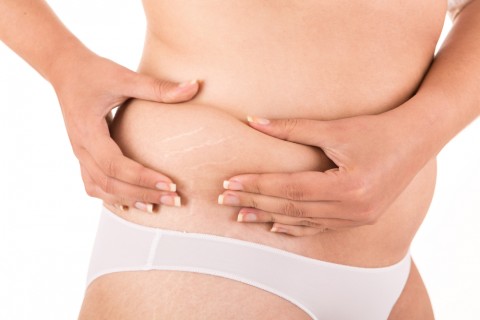
Many people relate stretch marks to a side effect of pregnancy, but the truth is that any time the skin is stretched beyond its normal capacity, stretch marks develop. Some people get stretch marks as a result of rapid growth, extreme weight gain or from developing muscles lifting weights or body building. Some very lucky individuals experience fading of their stretch marks over time, but the majority of those who suffer these telltale stripes this is not the case. There is hope for treating stretch marks, however. This hope is called the SkinPen.
That cause of stretch marks is actually unknown, but as their name suggests, they develop in part as a result of the skin being stretched beyond its limit. Some researchers believe there is a link between the marks and high levels of cortisol, a stress hormone that breaks down the collagen, fibrillin and elastin proteins of the skin. Collagen, fibrillin, and elastin are proteins essential for healthy skin and give the skin its shape and its ability to return to its original size after being stretched or contracted. When these proteins are broken down or depleted, the ability of the skin to accommodate stretching is diminished. As a result, a stretch mark develops.
There is no way to completely prevent stretch marks from developing, although there are many over the counter treatments and plenty of old wives’ tale remedies that make claims of warding off these skin woes. While they cannot be prevented, there are several treatments available. Treatments include creams that include Retin-A, which is a vitamin A derivative that restores collagen and improves skin elasticity, and pulsed dye laser therapy that uses pulsed laser energy to treat stretch marked skin, and other conditions like hemangiomas and port wine stain birthmarks. There is also skin resurfacing treatments like Microdermabrasion, in which damaged skin is sloughed away with tiny crystals, revealing more elastic skin below. While all of these treatments may help to reduce the appearance of stretch marks, one of the most effective treatments for the condition is the SkinPen.
The SkinPen is a microneedling device that houses 12 tiny surgical-grade needles. This pen-sized machine delivers tiny, microscopic punctures to the skin affected by the stretch marks. In response to these micro-injuries, the body ramps up its production of collagen and elastin. The increase in these proteins then increases the skin’s ability to stretch and rebound. Increased collagen production also yields skin tightening benefits, giving a lift to loose skin.
“The benefits of the SkinPen are many,” Dr. Jack Peterson said. Peterson is a Topeka, KS plastic surgeon who provides skin rejuvenating therapies to his patients.
“One major benefit is the treatment is used in areas with stretch marks, like the abdomen, thighs, and arms, but it can also be used on the face and neck to reduce the signs of aging, acne scars and spots of sun damage,” he said.” As there is no heat generated by the treatment, there is no risk of uneven results or burns.”
The treatment is quick- usually only 30 minutes to an hour, and is performed in Peterson’s office. There is no downtime for the procedure, and Peterson expects that most patients resume normal activity within a few hours of treatment.
“The procedure is not particularly painful, but in many cases, a topical analgesic agent is applied to the skin to numb the skin to make sure the patient is comfortable,” he said. “Most people liken their appearance and how their skin feels after the procedure to mild sunburn.”
Most SkinPen patients describe the feeling of the treatments as a slight vibration, and after the procedure, the skin will appear pink or red. After the procedure, patients are given a soothing skin treatment and are free to go home or about their regular routine. There is no photosensitivity with SkinPen like with other skin rejuvenating treatments, but it is always a good idea to wear a high quality, broad spectrum sunscreen with a sun protection factor of at least 30, cautions Peterson.
After SkinPen, patients are given a post-treatment skin care plan that will maximize their stretch mark treatment results. Most patients need a few treatments for optimal results, and Dr. Peterson suggests that patients separate them out by at least four weeks.

